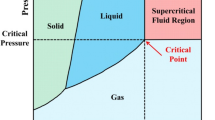Abstract
Various mechanical properties (uniaxial compression, Poisson’s ratio, indentation resistance) were measured for both expanded polypropylene (EPP) foam and bonded-polypropylene-bead foam. Finite Element Analysis, used on Body Centred Cubic (BCC) lattice models of uniform sized beads, predicted that the compressive response of EPP was hardly affected by the small volume fraction of inter-bead channels, whereas the bonded-bead foam with 25% porosity should have a near-linear compressive impact response. The foam lateral expansion on compression was predicted to be less than 3.5%, which was confirmed by experiment. Computational Fluid Dynamics was used to predict the air permeability of the models. An overlapping sphere model confirmed an earlier analysis, whereas a wet Kelvin foam model gave slightly lower permeabilities. The permeability increases with the square of the bead diameter and with the 2.6th power of the porosity.













Similar content being viewed by others
References
Svec P, Rosik L, Horak Z (1990) Styrene based plastics and their modification. Ellis Horwood, London
Skinner SJ, Baxter S, Eagleton SD, (1965) Plast Eng 42:171
Mills NJ (1997) Cell Polym 16:194
Beverte I (2004) J Cell Plast 40:191
Ibba A, Avalle M (2003) Identificazione di schiume in polipropilene e relazione tra densita e parametric dei modelli, www.pcm.unifi.it/lavorasalerno/ART_056.pdf (AIAS Congress, Salerno)
Zohdi TI (2003) Proc Roy Soc 459A:1395
Mills NJ (2004) Polyolefin foams, RAPRA review report 167 (vol 14, no 11) ISBN 1-85957-434-3, 136 pp
Mills NJ (2005) J Mater Sci 40:5845
Hill RG, Koch DL, Ladd AJC (2001) J Fluid Mech 448:243
Larson RE, Higdon JJL (1988) Phys Fluids A1:38
Bainbridge DW, Nickerson LP, Denton GC (2002) US Patent 6,453,477 Protective padding for sports gear
Mills NJ (1994) In: Hilyard NC, Cunningham A (eds) Low density cellular plastics, Chapman & Hall, 270–318
Mills NJ (2005) Plastics: microstructure and engineering applications, 3rd edn Butterworth Heinemann, p 126
Mills NJ, Gilchrist A (2000) Cell Polymer 19:389
Mills NJ, Gilchrist A (2005) Dynamic FEA of bicycle helmet oblique impact, submitted to Int J Impact Eng
Surface Evolver (2004) at //www.susqu.edu/facstaff/b/brakke/evolver/
Mills NJ (2007) Int J Solids Struct 44:51
Masso-Moreu Y, Mills NJ (2003) Int J Impact Eng 28:653
Fluent Manual, Fluent Inc, Lebanon, USA
Zhu H, Mills NJ, Knott JF (1997) J Mech Phys Solids 45:1875
Avalle M, Belingardi G, Montanini R (2001) Int J Impact Eng 25:455
Acknowledgment
The authors thank EPSRC for support under Grant R89790, and both Brock USA and BASF for providing foams.
Author information
Authors and Affiliations
Corresponding author
Rights and permissions
About this article
Cite this article
Mills, N.J., Gilchrist, A. Properties of bonded-polypropylene-bead foams: data and modelling. J Mater Sci 42, 3177–3189 (2007). https://doi.org/10.1007/s10853-006-1357-0
Received:
Accepted:
Published:
Issue Date:
DOI: https://doi.org/10.1007/s10853-006-1357-0




